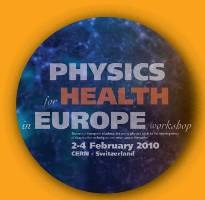Gerd Beyer
(Department of Radiology)
Systemic radionuclide therapy is a very challenging field of nuclear medicine. The search of new tracers that may become a radiopharmaceutical is driven mainly by disciplines as biochemistry, organic chemistry and coordination chemistry, while modern radiochemical or nuclear physics achievements are often not adequately included. Frequently the development of new radiopharmaceuticals is limited to the use of the rather small number of radionuclides that are commercially available.
We will review a series of experiments that have been performed from 1975 to 2005 in an interdisciplinary collaboration between nuclear medical institutions, radiochemistry and CERN-ISOLDE. We will illustrate how present-day technology developed partially at CERN (high energy proton induced reactions combined with high-tech physico-chemical separation techniques) improves the quality and choice of radioisotopes enormously.
These new high quality research radionuclides can significantly increase the efficiency in R&D towards improved systemic radionuclide therapies.
The biological response as function of the individual radionuclide can be studied systematically with higher efficiency. The same concerns the relation between radiation energy and biological response for different lesion sizes.
We will present results from particularly efficient simultaneous multi-isotope measurements of biodistributions of several chelates and conjugates of rare earth elements. We also show examples of innovative PET and SPECT isotopes that, since they exhibit the same biodistribution as the respective therapy isotope, may serve for personalized in-vivo dosimetry.
In conclusion these experiments show the potential of introducing new commercially not available carrier-free radionuclides for diagnostics and therapy.
E-mail address
Gerd-Jurgen.Beyer@cern.ch
Telephone
Last Name
First Name(s)
Please submit a short bio (max 1500 characters)
Prof. Dr.rer.nat.habil. Gerd-Jürgen BEYER is a classical Radiochemist:
TU Dresden, D: PhD 1968, Habil. 1978, Prof. in Radiochemistry 1983.
Research fellow at JINR Dubna, RUS 1967-75, postdoc Aarhus, DK 1971.
Several leading positions at CINR Rossendorf, D 1975–91
1991-93 Scientific Associate CERN
1993-95 Guest Prof. Univ. of Geneva
1996-2005 Head of Cyclotron Unit of HCUGE Geneva
Since retirement 2005: Scientific Advisor of Isotope Technologies Dresden GmbH. Since 12 years Lecturer at ESI&JUAS Archamps, F on Isotopes in Medicine
Since 1984 expert of IAEA Vienna in medical isotope and radiopharmaceutical production.
Scientific fields: fast radiochem. separation techniques for basic research and application in isotope production, radiopharmaceutical development and production, use of particle physics research facilities for biomedical research, formulation of the nuclear medical research program at CERN-ISOLDE. Today active in implementation of medium scale LEU-fission-based 99Mo production technologies.
He developed new techniques for off-line and on-line isotope separation, innovative methods for fast radiochemical separations based on chemical effects of nuclear transformations, discovered few new short-lived isotopes. He worked with very few atoms as well as multi-kCi activities, is experienced with the problems in large scale commercial isotope production and making available non-standard isotopes for research.
About 200 publications in internat. journals, books, patents.
Address
Institution
Isotope Technologies Dresden
Prof.
Gerd-Jürgen Beyer
(Isotope Technologies Dresden)
Dr
Helge Ravn
(formerly CERN)
Dr
Ulli Köster
(Institut Laue Langevin Grenoble)
